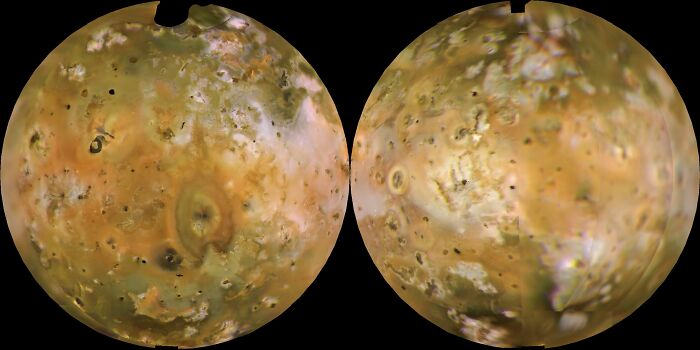
NASA’s Juno Spacecraft Delivered A Spectacular Aerial View From Io, Including Mountains And A Lava Lake
Image credits: NASA
Loki Patera is the largest volcanic depression on Jupiter’s moon Io. The lava lake is directly connected to a magma reservoir below. It was first spotted from Earth by the Large Binocular Telescope Observatory in Arizona and was named after a Norse god (a patera is a bowl-shaped volcanic crater).
On March 8, 2015, another moon of Jupiter, called Europa, passed in front of Io, gradually blocking out light from the volcanic moon, which let the research team led by scientists at the University of California at Berkeley obtain a detailed map of the volcanic lake.
“This is the first useful map of the entire patera. It shows not one but two resurfacing waves sweeping around the patera. This is much more complex than what was previously thought,” shared Dr. Ashley Davies from NASA’s Jet Propulsion Laboratory at the time.
“This is a step forward in trying to understand volcanism on Io, which we have been observing for more than 15 years, and in particular the volcanic activity at Loki Patera,” added Imke de Pater, a professor of astronomy from the University of California at Berkeley.
Loki Patera is the largest volcanic depression on Jupiter’s moon Io. The lava lake is directly connected to a magma reservoir below. It was first spotted from Earth by the Large Binocular Telescope Observatory in Arizona and was named after a Norse god (a patera is a bowl-shaped volcanic crater).
On March 8, 2015, another moon of Jupiter, called Europa, passed in front of Io, gradually blocking out light from the volcanic moon, which let the research team led by scientists at the University of California at Berkeley obtain a detailed map of the volcanic lake.
“This is the first useful map of the entire patera. It shows not one but two resurfacing waves sweeping around the patera. This is much more complex than what was previously thought,” shared Dr. Ashley Davies from NASA’s Jet Propulsion Laboratory at the time.
“This is a step forward in trying to understand volcanism on Io, which we have been observing for more than 15 years, and in particular the volcanic activity at Loki Patera,” added Imke de Pater, a professor of astronomy from the University of California at Berkeley.
Advertisements



